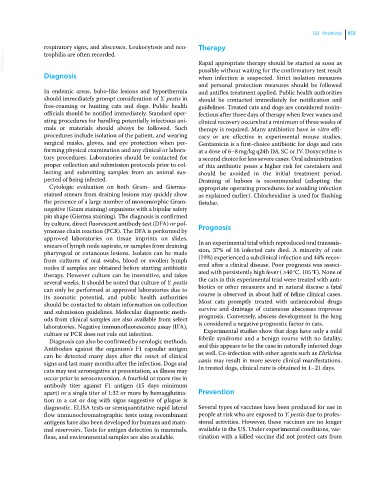Page 1015 - Clinical Small Animal Internal Medicine
P. 1015
102 Yersiniosis 953
respiratory signs, and abscesses. Leukocytosis and neu Therapy
VetBooks.ir trophilia are often recorded. Rapid appropriate therapy should be started as soon as
Diagnosis possible without waiting for the confirmatory test result
when infection is suspected. Strict isolation measures
and personal protection measures should be followed
In endemic areas, bubo‐like lesions and hyperthermia and antiflea treatment applied. Public health authorities
should immediately prompt consideration of Y. pestis in should be contacted immediately for notification and
free‐roaming or hunting cats and dogs. Public health guidelines. Treated cats and dogs are considered nonin
officials should be notified immediately. Standard oper fectious after three days of therapy when fever wanes and
ating procedures for handling potentially infectious ani clinical recovery occurs but a minimum of three weeks of
mals or materials should always be followed. Such therapy is required. Many antibiotics have in vitro effi
procedures include isolation of the patient, and wearing cacy or are effective in experimental mouse studies.
surgical masks, gloves, and eye protection when per Gentamicin is a first‐choice antibiotic for dogs and cats
forming physical examination and any clinical or labora at a dose of 6–8 mg/kg q24h IM, SC or IV. Doxycycline is
tory procedures. Laboratories should be contacted for a second choice for less severe cases. Oral administration
proper collection and submission protocols prior to col of this antibiotic poses a higher risk for caretakers and
lecting and submitting samples from an animal sus should be avoided in the initial treatment period.
pected of being infected. Draining of buboes is recommended (adopting the
Cytologic evaluation on both Gram‐ and Giemsa‐ appropriate operating procedures for avoiding infection
stained smears from draining lesions may quickly show as explained earlier). Chlorhexidine is used for flushing
the presence of a large number of monomorphic Gram‐ fistulae.
negative (Gram staining) organisms with a bipolar safety
pin shape (Giemsa staining). The diagnosis is confirmed
by culture, direct fluorescent antibody test (DFA) or pol Prognosis
ymerase chain reaction (PCR). The DFA is performed by
approved laboratories on tissue imprints on slides,
smears of lymph node aspirate, or samples from draining In an experimental trial which reproduced oral transmis
pharyngeal or cutaneous lesions. Isolates can be made sion, 37% of 16 infected cats died. A minority of cats
from cultures of oral swabs, blood or swollen lymph (19%) experienced a subclinical infection and 44% recov
nodes if samples are obtained before starting antibiotic ered after a clinical disease. Poor prognosis was associ
therapy. However culture can be insensitive, and takes ated with persistently high fever ( ≥40 °C, 105 °F). None of
several weeks. It should be noted that culture of Y. pestis the cats in this experimental trial were treated with anti
can only be performed at approved laboratories due to biotics or other measures and in natural disease a fatal
its zoonotic potential, and public health authorities course is observed in about half of feline clinical cases.
should be contacted to obtain information on collection Most cats promptly treated with antimicrobial drugs
and submission guidelines. Molecular diagnostic meth survive and drainage of cutaneous abscesses improves
ods from clinical samples are also available from select prognosis. Conversely, abscess development in the lung
laboratories. Negative immunofluorescence assay (IFA), is considered a negative prognostic factor in cats.
culture or PCR does not rule out infection. Experimental studies show that dogs have only a mild
Diagnosis can also be confirmed by serologic methods. febrile syndrome and a benign course with no fatality,
Antibodies against the organism’s F1 capsular antigen and this appears to be the case in naturally infected dogs
can be detected many days after the onset of clinical as well. Co‐infection with other agents such as Ehrlichia
signs and last many months after the infection. Dogs and canis may result in more severe clinical manifestations.
cats may test seronegative at presentation, as illness may In treated dogs, clinical cure is obtained in 1–21 days.
occur prior to seroconversion. A fourfold or more rise in
antibody titer against F1 antigen (15 days minimum
apart) or a single titer of 1:32 or more by hemagglutina Prevention
tion in a cat or dog with signs suggestive of plague is
diagnostic. ELISA tests or semiquantitative rapid lateral Several types of vaccines have been produced for use in
flow immunochromatographic tests using recombinant people at risk who are exposed to Y. pestis due to profes
antigens have also been developed for humans and mam sional activities. However, these vaccines are no longer
mal reservoirs. Tests for antigen detection in mammals, available in the US. Under experimental conditions, vac
fleas, and environmental samples are also available. cination with a killed vaccine did not protect cats from

